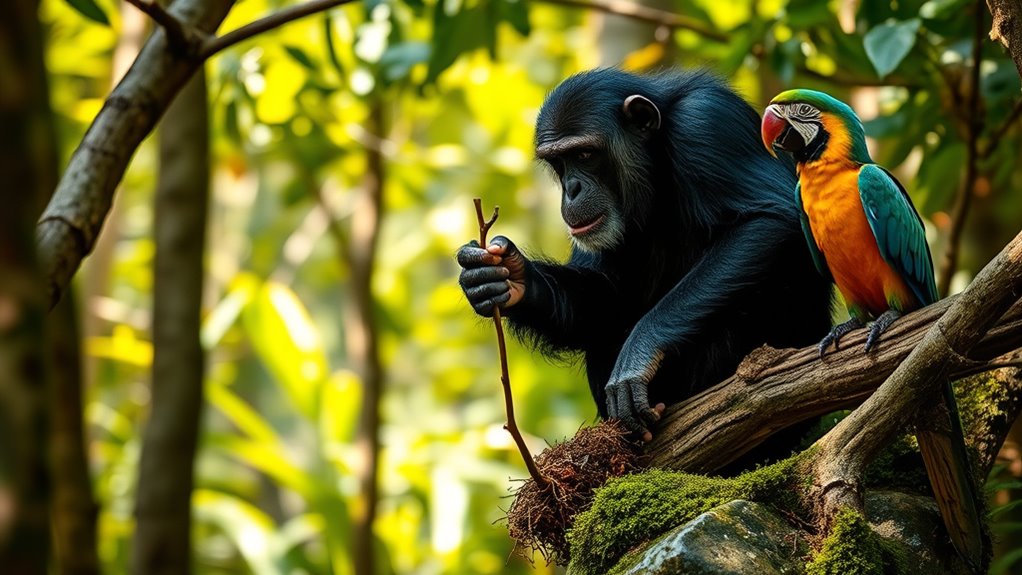Animals in the wild use tools in astonishing ways. Chimpanzees create sticks to fish for termites, while crows craft hooks from twigs for insect extraction. Capuchin monkeys select the right stones to crack open tough nuts. Sea otters even use rocks to break shells open. This clever problem-solving showcases their adaptability. Each species has unique methods, and these skills play a crucial role in their survival. You'll find even more fascinating examples of animal ingenuity as you explore further.
Key Takeaways
- Various species, including primates, birds, and marine animals, utilize tools to enhance foraging efficiency and adapt to their environments.
- Chimpanzees and capuchin monkeys demonstrate advanced problem-solving skills by selecting appropriate tools for tasks like termite fishing and nut-cracking.
- New Caledonian crows and kea parrots exhibit innovative tool-making and behavioral flexibility, creating tools to access food sources.
- Sea otters and dolphins use tools to protect themselves and access prey, showcasing cognitive complexity in their tool use behaviors.
- Social learning plays a crucial role, as young animals observe and learn tool use techniques from experienced individuals within their groups.
The Evolution of Tool Use in Animals

As you explore the fascinating world of tool use in animals, you'll find that this behavior has evolved independently across various species, highlighting the concept of convergent evolution.
Different animals, from crows using sticks to chimps foraging, show remarkable adaptations shaped by ecological demands. Tool use isn't limited to primates; sea otters and elephants also demonstrate specialized behaviors that enhance their survival.
This suggests that tool use is an adaptive trait, allowing animals to efficiently exploit resources in their environments.
Curiously, research reveals that tool use isn't solely tied to high intelligence, as many species exhibit varying degrees of tool-related behaviors. This challenges traditional views on cognitive complexity, emphasizing that adaptation can manifest in various forms across the animal kingdom.
Notable Tool-Using Primates
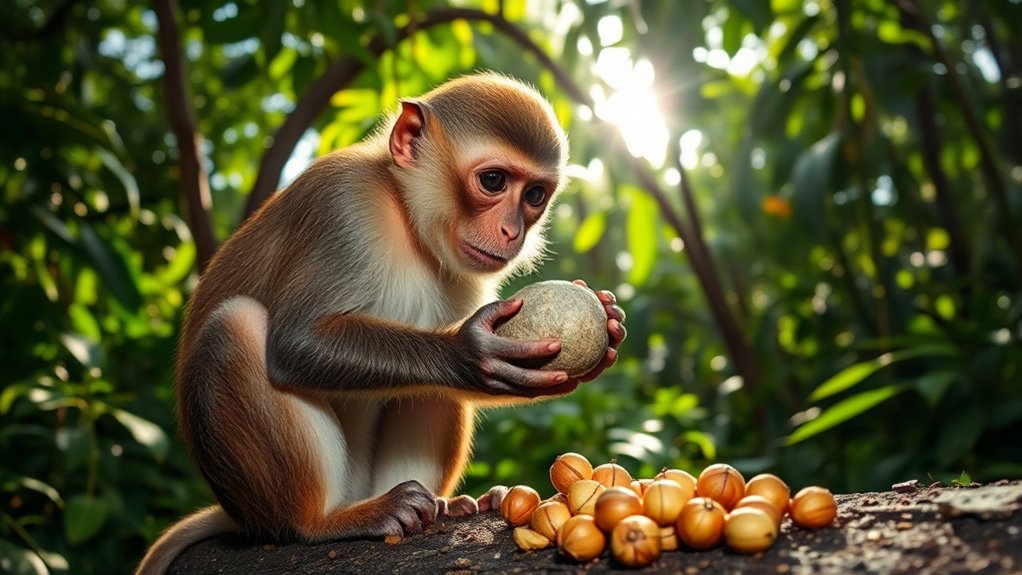
When you think about tool-using primates, chimpanzees immediately come to mind with their impressive foraging techniques.
Capuchin monkeys also stand out, showing cleverness in selecting the right tools for cracking open tough fruits.
These behaviors highlight the innovative problem-solving skills that define these fascinating species.
Chimpanzee Foraging Techniques
Chimpanzees demonstrate remarkable foraging techniques by skillfully using tools to access food sources that would otherwise be out of reach. For instance, they often manipulate sticks to extract termites from mounds, showcasing their understanding of tool use. They also use stones to crack open nuts and employ leaves as sponges for soaking up water. This diverse tool use highlights their cognitive complexity and adaptability.
| Tool Type | Purpose |
|---|---|
| Sticks | Extracting termites |
| Stones | Cracking nuts |
| Leaves | Soaking up water |
Through social learning, chimpanzees pass on these foraging skills to younger members, enhancing survival strategies within their communities. Their innovative approaches make them fascinating subjects for studying animal intelligence.
Capuchin Monkey Tool Selection
While chimpanzees showcase impressive foraging skills, capuchin monkeys take tool use to another level with their strategic selection and application.
These clever primates demonstrate remarkable cognitive flexibility through their tool selection. Here are three key aspects of capuchin monkeys' tool use:
- Material Choice: They choose rocks based on weight and durability, ensuring effectiveness when smashing hard fruits and nuts.
- Social Learning: Capuchin monkeys learn through observation, with older individuals guiding the younger ones in their tool use techniques.
- Contextual Use: They employ tools not just for foraging but also for defense, highlighting the importance of tool selection in their survival strategies.
This adaptability showcases the advanced cognitive abilities of capuchin monkeys in wild environments.
Innovative Problem-Solving Behaviors
Notable tool-using primates exhibit innovative problem-solving behaviors that highlight their cognitive abilities.
Chimpanzees, for instance, use sticks to extract termites and stones to crack open nuts, revealing advanced tool use.
Capuchin monkeys select rocks based on weight and durability to smash open hard fruits, showcasing their adaptability in tool use.
Gorillas utilize sticks to measure water depth and create bridges, demonstrating opportunistic tool use based on their environment.
New Caledonian crows go a step further, crafting tools by whittling sticks into hooks for larvae extraction.
Research indicates that chimpanzees and capuchin monkeys engage in social learning, teaching younger members of their communities effective tool use.
These behaviors underline the remarkable cognitive skills of animals that use tools in the wild.
Ingenious Birds and Their Tool Use
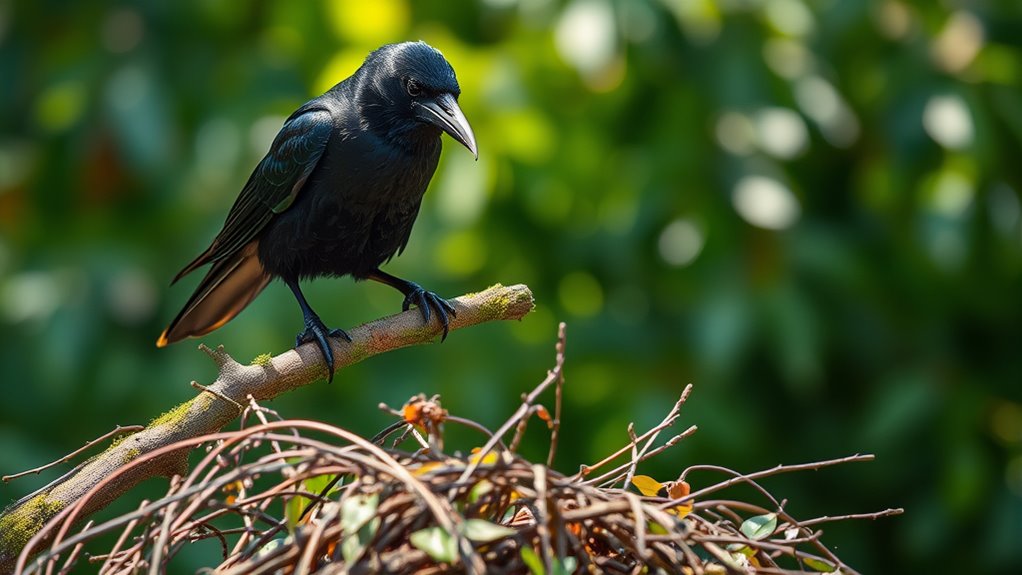
When you think about tool use in the animal kingdom, birds mightn't be the first creatures that come to mind, yet many species showcase remarkable ingenuity.
Among these ingenious birds, you'll find:
- New Caledonian crows: They create hooked tools from twigs and leaves to extract insects from tree bark, displaying impressive problem-solving skills.
- Kea parrots: These clever birds use sticks to solve complex puzzles and extract food, demonstrating behavioral flexibility and cognitive prowess.
- Woodpecker finches: They utilize twigs to access insects, illustrating learned behavior shaped by their environment.
These examples highlight how birds adapt their tool use to thrive, proving that intelligence in the animal kingdom comes in many forms.
Marine Animals: Tools of the Sea
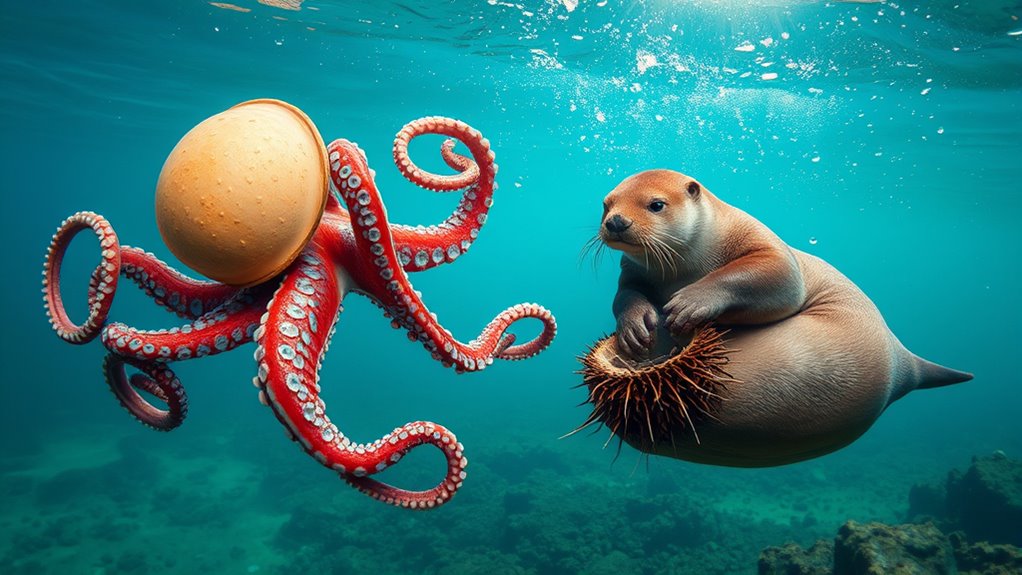
Many might be surprised to learn that tool use isn't limited to land animals; it also exists in the ocean's depths. Marine animals showcase fascinating behaviors that challenge our perceptions of intelligence.
For instance, sea otters use stone tools to crack open hard-shelled prey like clams, revealing their problem-solving skills. Bottlenose dolphins cleverly employ marine sponges to protect their snouts while foraging in Shark Bay, a behavior passed down through generations.
Meanwhile, coconut octopuses carry shell halves to create shelters, showing advanced planning. Even California sheephead wrasse use rocks as anvils to crush invertebrates, enhancing their foraging efficiency.
These examples highlight the adaptability and cognitive complexity of marine species, broadening our understanding of animal behavior in aquatic ecosystems.
Unconventional Tool Users: Mammals and Insects
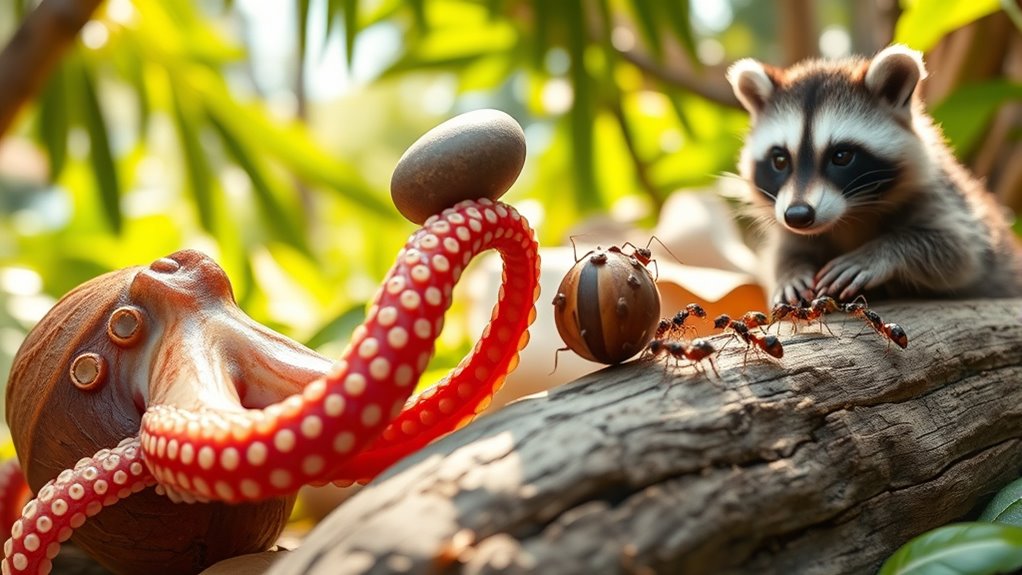
While you might typically think of tool use as a trait of highly intelligent species, unconventional users like mammals and insects demonstrate that ingenuity can take many forms.
Consider these fascinating examples of animal tool use:
- African elephants use heavy branches to manipulate their environment, showcasing problem-solving skills.
- Bottlenose dolphins forage with marine sponges to protect their snouts, a cultural behavior passed from mothers to daughters.
- Bicolored pyramid ants drop stones to block competitors, exhibiting defense strategies with available materials.
These remarkable animal uses of tools highlight that ingenuity isn't limited to traditional views of intelligence.
From pigs using their snouts to uncover food to weaver ants crafting nests with silk, these mammals and insects prove that using tools is a versatile survival strategy.
The Role of Social Learning in Tool Use
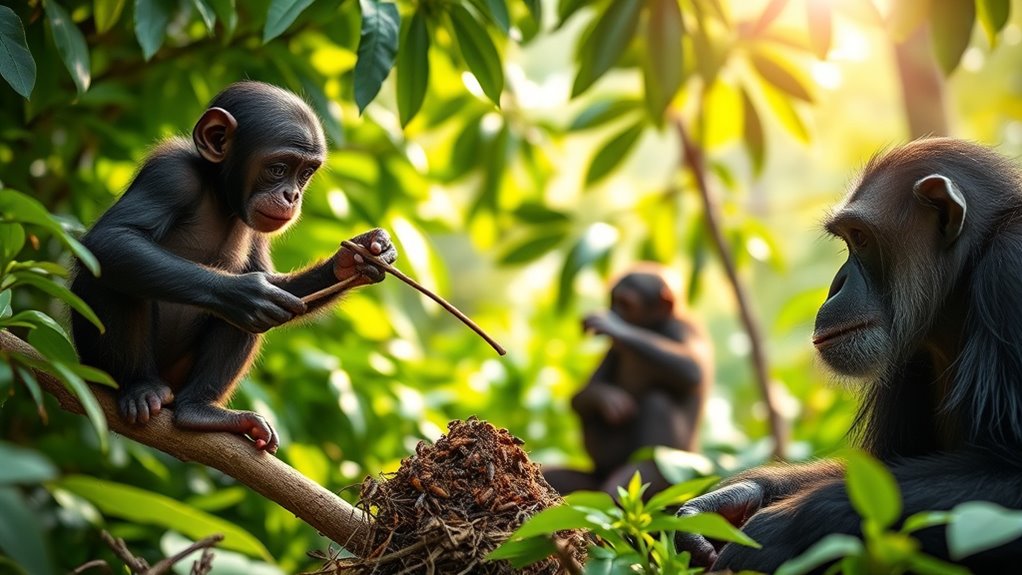
When you watch animals like chimpanzees or dolphins, you'll notice how much they rely on social learning to master tool use.
By observing skilled group members, they pick up techniques and pass on knowledge, showcasing a fascinating cultural transmission of skills.
This highlights the significant impact that social interactions have on their ability to innovate and adapt.
Observational Learning Techniques
Observational learning greatly enhances the way animals acquire tool use skills, as they can effortlessly mimic the actions of their peers. Researchers have observed various species mastering tool use through social learning, highlighting key techniques:
- Mimicking Actions: Young chimpanzees learn to use sticks for termite fishing by watching their mothers.
- Selecting Tools: Capuchin monkeys observe experienced tool users to choose appropriate nuts for cracking based on weight and durability.
- Innovating Tools: New Caledonian crows modify and create tools by observing others, showcasing their cognitive flexibility.
These techniques emphasize how social interactions and environmental contexts shape learning processes.
Cultural Transmission of Skills
Cultural transmission of tool-use skills among animals showcases how social learning helps shape behaviors within populations. Young individuals often learn from experienced group members, like chimpanzees teaching offspring to use sticks for termite fishing. Similarly, bottlenose dolphins pass down sponge-using techniques from mothers to calves. New Caledonian crows craft tools, sharing techniques within local groups, while capuchin monkeys observe peers to enhance their tool use. This cultural transmission leads to regional variations in tool-making, as seen in sea otters' unique shell-cracking methods.
| Animal Species | Tool Use Example |
|---|---|
| Chimpanzees | Sticks for termite fishing |
| Bottlenose Dolphins | Sponges for snout protection |
| New Caledonian Crows | Crafting tools from their environment |
Impact of Social Groups
Social learning plays an essential role in how tool use develops within animal communities, as individuals often rely on their social groups to acquire new skills.
For example, you can observe how different species utilize social learning in their tool use:
- Chimpanzees learn termite extraction techniques by watching their mothers, showcasing the importance of familial guidance.
- New Caledonian crows enhance their problem-solving skills by imitating others in their group, which leads to more effective tool-making.
- Capuchin monkeys teach each other to select rocks for nut-cracking, emphasizing the role of peer interactions in skill development.
These examples highlight how social dynamics influence the transmission of tool use knowledge, ultimately shaping the behaviors of various species.
The Impact of Tool Use on Survival Strategies
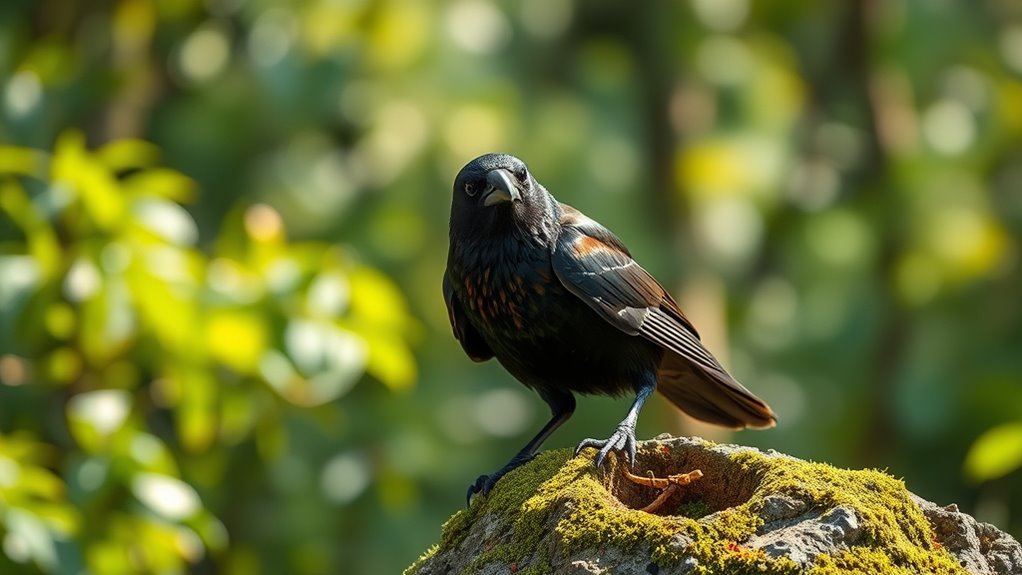
When animals use tools, they greatly enhance their survival strategies, allowing them to access food sources that would otherwise be out of reach.
For instance, southern sea otters use stones to crack open shellfish, essential for their diet. Similarly, chimpanzees improve foraging efficiency by using sticks to extract termites and stones to crack nuts.
Southern sea otters and chimpanzees exemplify tool use, enhancing their foraging efficiency and food access in the wild.
Bottlenose dolphins cleverly employ marine sponges as tools to protect their snouts while foraging, expanding their prey options.
New Caledonian crows showcase advanced problem-solving by creating hooked sticks to extract larvae from tree bark.
Even octopuses use coconut shells as protection against predators, demonstrating that tool use offers multifaceted benefits, enhancing both foraging success and overall survival strategies in the wild.
Fascinating Examples of Animal Ingenuity

Animal ingenuity shines through in their diverse and innovative use of tools.
You'll be amazed by how different species creatively solve problems using their environment. Here are three fascinating examples:
- New Caledonian Crows: They craft hooked tools from twigs to extract larvae from tree bark, showcasing their impressive problem-solving skills.
- Southern Sea Otters: These clever animals use rocks to crack open hard-shelled prey, storing their favorite stones in pockets within their fur for easy access.
- Chimpanzees: They use sticks to extract termites and stones to crack nuts, demonstrating their ability to learn from each other.
These incredible examples remind us that tool use isn't just a human trait, but a remarkable part of animal behavior.
Frequently Asked Questions
What Are Three Examples of Tool Use by Animals in the Wild?
When you think about animals using tools, you'll find some fascinating examples.
Chimpanzees use sticks to extract termites, showcasing their intelligence.
New Caledonian crows craft hooked tools from twigs to pull out larvae, highlighting their creativity.
Southern sea otters grab rocks to crack open clams, demonstrating their dexterity.
Each of these examples reflects not only the animals' skills but also their ability to adapt to their environments for survival.
Do Animals Know How to Use Tools?
Imagine a clever crow, its beak poised like a painter's brush, crafting a masterpiece of survival. Yes, animals do know how to use tools!
They demonstrate remarkable intelligence by manipulating objects to achieve goals, whether it's cracking open a nut or fishing for dinner. These creatures observe, learn, and innovate, showcasing their ability to adapt in various environments.
With each clever maneuver, they reveal a world of cognitive depth you might never expect.
What Animals Can Use Weapons?
When you think about animals that can use weapons, consider chimpanzees, capuchin monkeys, and African elephants.
Chimpanzees often wield sticks and stones for hunting or defense, while capuchin monkeys select rocks to crack open tough nuts.
African elephants use heavy branches to fend off threats.
Even birds like great blue herons employ objects to lure fish.
These examples reveal that various animals have adapted their abilities to use weapons effectively in their environments.
What Animals Use Rocks as Tools?
When you think about animals that use rocks as tools, several come to mind.
Southern sea otters crack open clams and mussels with selected stones.
Chimpanzees utilize rocks to break nuts and sticks to grab termites.
Capuchin monkeys also demonstrate this behavior, smashing fruits with rocks.
Even fish, like the California sheephead wrasse, use rocks as anvils for crushing prey.
Finally, the coconut octopus creatively employs shells and rocks for protection.
Conclusion
In the grand tapestry of nature, tool use weaves a vibrant thread that showcases the ingenuity of animals. From clever primates to resourceful birds, each creature demonstrates that survival often hinges on creativity and adaptability. As you explore the wild, remember that these remarkable skills not only enhance their lives but also reveal the complex interplay of intelligence and environment. So, next time you observe animals, keep an eye out for their hidden talents—you might just witness nature's brilliance in action!
